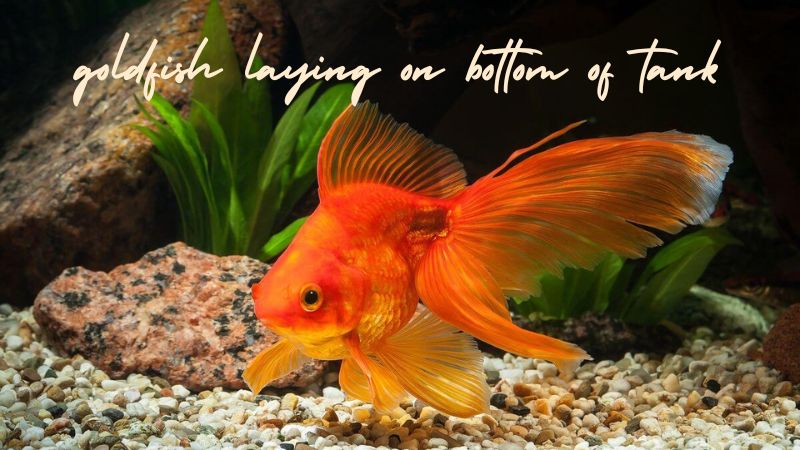Why goldfish laying on bottom of tank? Goldfish (Carassius auratus) are one of the most popular aquarium fish in the world. They are loved not only for their brilliant beauty but also for their gentle personality, easy to raise and ability to live in many different conditions. However, there is a phenomenon that many goldfish owners often encounter: goldfish lying at the bottom of the tank. This phenomenon can be a sign of many different problems, from natural causes to serious health problems. In this article, Tropical Fish Haven will delve into why goldfish lay on the bottom of tank and the appropriate treatment measures.
Why goldfish laying on bottom of tank?
Natural causes
Natural behavior
Some fish species have a habit of lying on the bottom of the tank as part of their natural behavior. Goldfish are no exception. Sometimes, goldfish lie at the bottom of the tank to rest after vigorous activity or after eating a full meal. This is normal behavior and is not a cause for concern if the fish does not show other unusual signs such as difficulty breathing, loss of color or not eating.
Adaptation time
When first moved into a new aquarium, goldfish may feel stressed and need time to adapt to the new environment. During this period, the fish can lie on the bottom of the tank to reduce stress. This behavior usually only lasts for a few days until the fish gets used to its new aquarium.
Health problems
Stress
Goldfish are very sensitive to their surroundings. Sudden changes in water temperature, water quality, or even changes in the living environment such as light or noise can cause stress to fish. When stressed, goldfish often tend to lie at the bottom of the tank to feel safer.
Diseases
Illness is one of the main reasons why goldfish stay at the bottom of the tank. Common diseases include:
- Fin rot: This is a bacterial infection that causes the fish’s fins to rot, resulting in the fish feeling pain and having difficulty moving, so they stay at the bottom of the tank.
- Fungal diseases: Fungi can attack fish and cause symptoms such as white cottony patches on the body, causing discomfort and causing the fish to lie on the bottom.
- Parasitic diseases: Parasites such as roundworms and flatworms can penetrate the fish’s body, causing the fish to weaken and lie on the bottom of the tank.
Digestive system problems
Goldfish can experience digestive system problems such as constipation or bloating. When constipated, the fish’s stomach will swell, making it difficult for the fish to float and they will lie at the bottom of the tank. Constipation often occurs when fish eat too much or eat inappropriate food.
Poisoned
Poisoning due to poor water quality is another reason why goldfish lie at the bottom of the tank. Toxins such as ammonia, nitrites and nitrates in water can cause serious health problems for fish. When the concentration of these substances is too high, fish will be poisoned and tend to lie dormant at the bottom of the tank.
Living environment issues
Water quality
Water quality is an important factor affecting the health of goldfish. The water in the tank needs to be tested regularly to ensure that indicators such as pH, ammonia, nitrite and nitrate levels are at safe levels. Water that is dirty or contains too many toxic substances will stress and weaken the fish, leading to them lying at the bottom of the tank.
Water temperature
Goldfish like to live in a water environment with a stable temperature of 20-22 degrees Celsius. Sudden changes in water temperature can shock the fish and cause them to lie at the bottom of the tank. Additionally, water that is too cold or too hot can be harmful to your goldfish’s health.
Dissolved oxygen
The level of dissolved oxygen in the water is also important. If the water in the tank lacks oxygen, the fish will find it difficult to breathe and may lie at the bottom of the tank to save energy. This often happens in aquariums with too many fish or a lack of filtration and aeration systems.
How to prevent and handle
Maintain water quality
To ensure the health of goldfish, maintaining water quality is very important. It is necessary to change water regularly, check water indicators and use effective water filtration equipment. The water filtration system not only helps remove toxic substances but also maintains the dissolved oxygen level necessary for fish.
Temperature control
Use a thermostat to control the water temperature in the aquarium. This helps ensure the water temperature is always stable and suitable for goldfish. Avoid placing the aquarium in places with large temperature changes, such as near windows or heat sources.
Oxygen supply
Use aeration devices or filters that provide oxygen to ensure the water in the tank always has enough oxygen for fish to breathe. At the same time, avoid placing too many fish in one tank to minimize oxygen deficiency.
Healthy eating mode
Make sure to provide your goldfish with a reasonable diet, with diverse and nutritious foods. Avoid feeding your fish too much or the wrong food, which can cause problems with your fish’s digestion and overall health.
Observe and check fish health regularly
Observe the goldfish’s behavior and health status regularly to detect unusual signs early. If you see the fish showing strange behavior such as lying on the bottom of the tank, losing color, or not eating, you need to check carefully to determine the cause and take timely measures.
Final Thoughts
Goldfish lying at the bottom of the tank is a common phenomenon but can be caused by many different reasons. From natural behavior, stress, disease, to environmental issues such as water quality, temperature and dissolved oxygen. Understanding these causes will help fish farmers have effective prevention and treatment measures, ensuring the best health and development for goldfish. Maintaining an ideal living environment, providing a reasonable diet and regularly checking your fish’s health will help you have healthy, active and beautiful goldfish.





